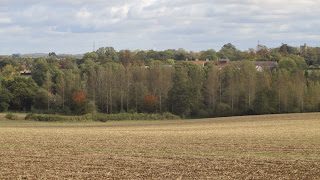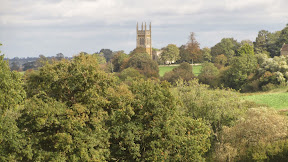 |
The setting for today's walk is the lovely village of East Haddon. It is a route taken from the Northamptonshire Walks website (walk no:86).
The walk started outside the Church of St Mary the Virgin on what was a bleak Autumn morning. Heavy rain is forecast for the afternoon so we needed to get cracking , at least it was fairly mild!
We walk down Main Street passing the old thatched Water Pump that supplied the village before there was a mains supply. Then the passing the Red Lion Pub and into countryside.
The footpath goes in two different directions, we climb the stile and head across open fields to the right . Lots of inquisitive sheep around as we approach another stile.
In the distance the weather has started to close in and it's a very murky picture, visibility is poor and the rain has increased.
It's a great shame because the views across the valley would be superb , at the moment it's just a drizzly blur. We cross a recently ploughed field which is a bit muddy.From there it is over another stile and a downhill trek along the field edge towards a farm.
Navigating through the farmyard and barns proved quite tricky. I'm always wary of upsetting the farmer who suddenly appears with a shotgun screaming 'get off my land. Thankfully all went peacefully and we made our way into more open fields.

 |
| Oak Trees |
It was at this point we went slightly wrong. Climbing the stile we continued downhill instead of going straight across and uphill. After backtracking we picked up the path which is part of the Macmillan Way.
There are another couple of stiles to cross as you go through the Holdenby estate through well trodden paths.
On reaching the road the walk continues straight across into the Holdenby estate. We took a slight detour to the right to look at Holdenby House.
The House dates back to 1583. Once the largest private house in England and subsequently the palace of James 1 and prison of Charles 1. Sitting on a hill overlooking 2000 acres of rolling countryside, its suite of elegant state rooms open onto beautiful Grade 1 listed gardens. It isn't open today though although that didn't stop us having a wander up the driveway for a closer but respectful look.
Getting back on track we head into the Holdenby Estate. Unless my eyes are deceiving me it has stopped raining and brightened up a little too! It's a bit like stepping back in time into an area where former estate workers would have lived. I suspect some probably still do?
There is a lovey old school building with it's lovely red door. It's not hard to imagine life here in a bygone era at all.
There is little sign of live anywhere in the hamlet today though. Everybody must be hunkered down indoors keeping warm and dry.
We make our way downwards following the sign for the historic church.
 | ||||
| Autumn colour |
We take a slight detour to visit 'All Saints Church which was unlocked , a rarity these days. The church now lies remote and isolated beside fields and a pond, beyond the gardens of Holdenby House. it is largely fourteenth century but the chancel was rebuilt in 1845 and Sir George Gilbert Scott restored the church in 1867. They say it is the church that lost it's village! Sir Christopher Hatton, Elizabeth I's Lord Chancellor, moved the village of Holdenby when he built his mansion. The name Holdenby derives from the time of Scandinavian settlements 'Halfdan'(or Haldane) meaning farm. It is mentioned in the Domesday book of 1086, and first records having a Rector around 1222. The whole church is built of local ironstone.
Unfortunately the rain has set in again and the wind is driving it in. There isn't a lot of cover on this part of the walk and it's a fairly bleak scene.
To compound matters we take a wrong turn and have to backtrack. Thankfully not a huge detour and we follow the farm track until reaching a signpost marked East Haddon on way, Althorp the other.
We take the East Haddon path and we really are in the middle of nowhere, well it seems like it anyway.
We did see one other walker though, another hardy soul braving the elements. The route takes us up a steep hill, which was a bit of a struggle in the conditions. I'm sure the views would have been quite spectacular on a clear day from the summit. Today wasn't that day though.
To our left is an old boarded up farmhouse 'Rowell Leyes'. Having made it to the top of the hill without the need for oxygen a slight breather is taken.
Following the field edge we head towards another farm building, they clearly don't welcome visitors or sodden walkers judging by the keep out boards. Sticking to the edge of the field we make our way to the laying field at East Haddon. I once played cricket for EH just before the pavilion was built. From there it is just a matter of following the path downhill back into the village. Coming out opposite the Red Lion.

















































